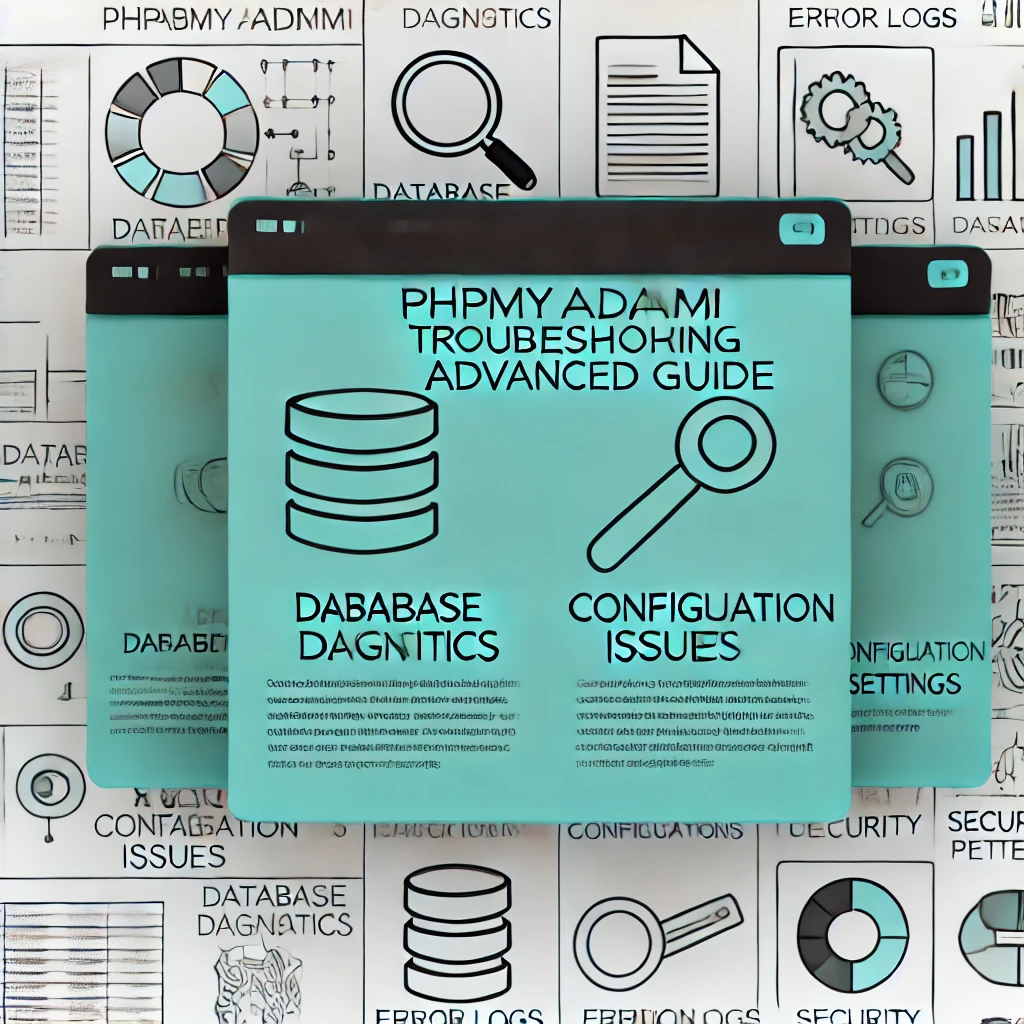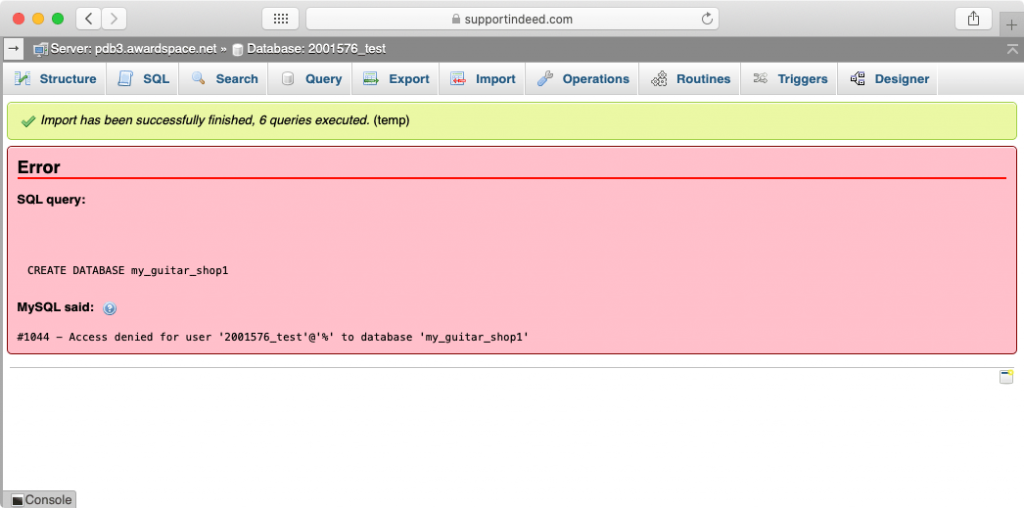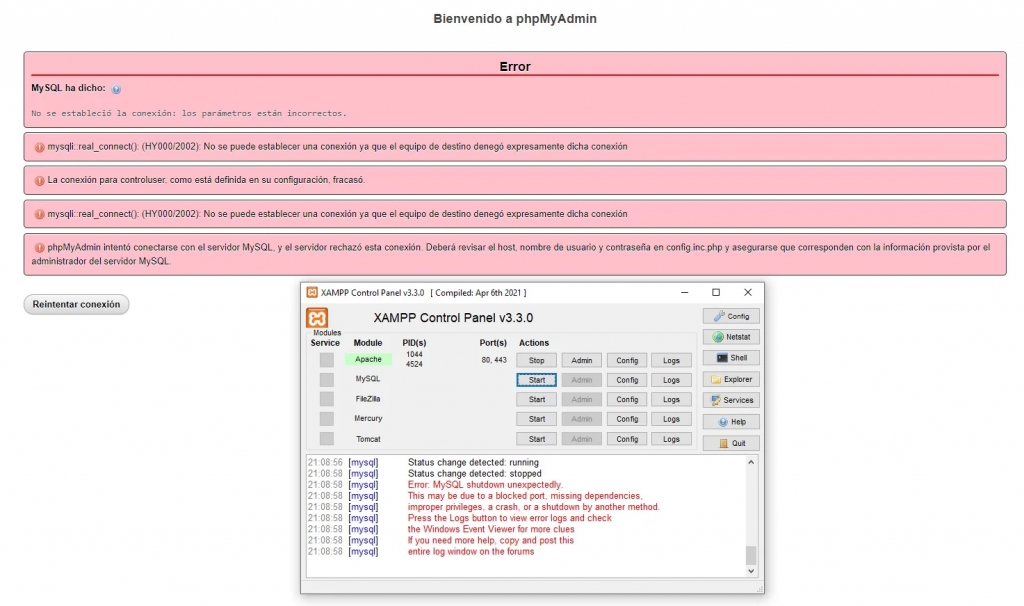Limited Time Offer!
For Less Than the Cost of a Starbucks Coffee, Access All DevOpsSchool Videos on YouTube Unlimitedly.
Master DevOps, SRE, DevSecOps Skills!

PHPMyAdmin is a powerful web-based tool designed for managing MySQL and MariaDB databases. It provides a user-friendly interface that makes database tasks like querying, importing/exporting data, managing tables, and adjusting permissions more accessible, even for users without in-depth knowledge of SQL commands. However, PHPMyAdmin’s complexity and reliance on a well-configured server environment mean that users and administrators frequently encounter various challenges and errors, especially in high-traffic or heavily customized installations.
In this guide, we aim to provide an advanced approach to PHPMyAdmin troubleshooting. We’ll cover common issues that arise during setup, database connectivity, performance optimization, and daily operation. As PHPMyAdmin operates in tandem with web servers, PHP, and MySQL/MariaDB configurations, many of these issues can be complex, involving multiple layers of server and application configurations. Effective troubleshooting in PHPMyAdmin often requires understanding the roles of various server components and identifying which layer—database, PHP, or web server—is responsible for a particular issue.
Why PHPMyAdmin Troubleshooting is Important?
Since PHPMyAdmin is widely used in production environments and by organizations of all sizes, it is essential to keep it running smoothly. Database errors or access issues can impact not only the performance and security of PHPMyAdmin but also the availability of critical data operations. From development to production, ensuring the reliability of PHPMyAdmin is crucial for:
- Streamlined Database Management: PHPMyAdmin simplifies complex database tasks, allowing for efficient data management. Troubleshooting helps keep these tasks smooth and prevents potential data handling errors.
- Maintaining Security: Misconfigurations can expose sensitive data to unauthorized access. Troubleshooting configuration issues mitigates security risks and ensures that access is properly controlled.
- Performance Optimization: As databases grow, PHPMyAdmin can experience performance slowdowns. Identifying bottlenecks and applying optimizations ensures PHPMyAdmin remains responsive, even in high-demand environments.
What are the Key Focus Areas of PHPMyAdmin Troubleshooting Guide?

This guide goes beyond basic troubleshooting and dives into advanced scenarios, focusing on:
- Installation and Configuration: From initial setup to modifying PHP and MySQL settings, this guide covers how to configure PHPMyAdmin and avoid common setup pitfalls.
- Database Connectivity: Database connection issues are some of the most common errors users encounter. We address connectivity troubleshooting and permissions management to resolve access problems.
- Performance and Resource Management: As PHPMyAdmin interacts with PHP and MySQL, performance issues may stem from insufficient memory, server limitations, or unoptimized queries. This guide provides insights into fine-tuning settings and improving performance.
- Import and Export Challenges: Managing database imports and exports can become complex, especially with large datasets. We explore techniques to overcome size limitations, script timeouts, and format compatibility.
- Advanced Debugging Techniques: PHPMyAdmin has several built-in options for debugging, along with server logs and PHP configurations. This guide explains how to use these tools effectively to isolate and resolve issues.
Each section of this guide will not only provide solutions to typical issues but will also include preventive measures, best practices, and practical examples. By following this guide, users can gain a deeper understanding of PHPMyAdmin’s inner workings and develop the skills to maintain a stable, efficient, and secure PHPMyAdmin environment. Whether you’re an administrator handling PHPMyAdmin in a high-traffic environment or a developer encountering specific database errors, this guide will be a valuable resource for resolving complex issues and enhancing your PHPMyAdmin setup.
Step by Step PHPMyAdmin Troubleshooting Advanced Guide

1. Introduction to PHPMyAdmin Troubleshooting
- Overview: PHPMyAdmin is a popular tool used to manage MySQL and MariaDB databases. Despite its powerful functionality, PHPMyAdmin may encounter errors due to misconfiguration, compatibility issues, or server constraints.
- Common Issues: Cover typical problems faced by users, such as configuration issues, access errors, import/export difficulties, and performance lags, setting the stage for the troubleshooting solutions.
2. Installation and Configuration Issues
- 404 Error (Not Found):
- Description: Often occurs when PHPMyAdmin’s alias isn’t configured correctly.
- Solution: Check your web server configuration files (
httpd.conffor Apache,nginx.conffor Nginx) and ensure the alias is set correctly to the PHPMyAdmin directory. For example,Alias /phpmyadmin "/usr/share/phpmyadmin"in Apache.
- 403 Forbidden Error:
- Solution: This usually stems from permission settings. Modify permissions to allow access, or check
AllowOverridedirectives in Apache’s configuration.
- Solution: This usually stems from permission settings. Modify permissions to allow access, or check
- Missing Dependencies:
- Solution: PHPMyAdmin requires specific PHP extensions like
mysqliandmbstring. Usephp -mto list enabled extensions andsudo apt install php-mbstring php-mysqlito install missing ones.
- Solution: PHPMyAdmin requires specific PHP extensions like
3. Login and Authentication Errors
- Invalid Login or Password:
- Solution: Verify credentials and ensure they match those in the MySQL database. Resetting the password via MySQL CLI (
ALTER USER 'username'@'localhost' IDENTIFIED BY 'new_password';) may also help.
- Solution: Verify credentials and ensure they match those in the MySQL database. Resetting the password via MySQL CLI (
- Token Mismatch / Session Timeout:
- Solution: Increase session timeout in
config.inc.phpusing$cfg['LoginCookieValidity'] = 1800;for 30 minutes. Ensure sessions are correctly stored if using filesystem or database storage.
- Solution: Increase session timeout in
- Login Loop:
- Solution: This often happens due to cookies or session conflicts. Enable cookies, clear cache, and adjust
session.save_pathinphp.iniif necessary.
- Solution: This often happens due to cookies or session conflicts. Enable cookies, clear cache, and adjust
4. Database Connectivity and Query Execution Issues
- Control User Connection Denied:
- Solution: Verify the control user settings in
config.inc.php. Ensure that the user exists in MySQL and has appropriate permissions with commands likeGRANT SELECT, INSERT, DELETE ON phpmyadmin.* TO 'pma'@'localhost';.
- Solution: Verify the control user settings in
- Max Connection Limit:
- Solution: Edit MySQL’s
my.cnffile to increasemax_connections. UseSHOW VARIABLES LIKE 'max_connections';to confirm, then restart MySQL for the changes to take effect.
- Solution: Edit MySQL’s
- Slow Query Execution:
- Solution: Enable the
slow_query_login MySQL, set an appropriatelong_query_time, and analyze queries. Indexing frequently queried columns can also enhance speed.
- Solution: Enable the
5. Memory and Performance-Related Issues
- Blank or Partially Loaded Pages:
- Solution: Increase
memory_limitinphp.ini(e.g.,memory_limit = 256M). Check for browser compatibility and JavaScript errors using browser developer tools.
- Solution: Increase
- Out of Memory on Import/Export:
- Solution: For large imports, set
memory_limit,upload_max_filesize, andpost_max_sizeinphp.inito higher values. Alternatively, use command-line imports (mysql -u username -p database_name < file.sql) for large data.
- Solution: For large imports, set
6. Import and Export Errors
- Script Timeout on Import:
- Solution: Increase
max_execution_timeandmax_input_timeinphp.ini. Split large SQL files if needed, or use command-line tools to bypass PHP limitations.
- Solution: Increase
- Incompatible File Format:
- Solution: Ensure compatibility of the imported file with MySQL’s syntax. Use
mysqldumpto create files in SQL format.
- Solution: Ensure compatibility of the imported file with MySQL’s syntax. Use
- Duplicate Entry Errors:
- Solution: Use options like
IGNOREinINSERTqueries orREPLACEinstead ofINSERTto manage duplicates. Alternatively, use command-linemysqlimportwith appropriate flags.
- Solution: Use options like
7. Common PHPMyAdmin Interface Errors
- Error #1045 – Access Denied:
- Solution: Reconfigure user privileges if access is denied. Run commands like
GRANT ALL PRIVILEGES ON *.* TO 'user'@'localhost' WITH GRANT OPTION;to adjust access.
- Solution: Reconfigure user privileges if access is denied. Run commands like
- PHPMyAdmin Stuck on Loading:
- Solution: Clear browser cache, switch to an alternate browser, and check for JavaScript errors that may be causing the hang.
- Missing PHP Extensions:
- Solution: Identify missing extensions with PHP’s
php -mcommand and install them as required (sudo apt-get install php-<extension>).
- Solution: Identify missing extensions with PHP’s
8. Backup and Data Recovery Issues
- Corrupted or Unusable Backups:
- Solution: Check backup file size, adjust
zlib.output_compression, and use tools likemysqlcheckto validate backup integrity.
- Solution: Check backup file size, adjust
- Restoring Tables and Recovering Data:
- Solution: If data loss occurs, use
REPAIR TABLEor restore from a recent backup. Regular automated backups ensure minimal data loss.
- Solution: If data loss occurs, use
9. Customization and Plugin-Related Issues
- Interface Display and Theme Issues:
- Solution: Reset PHPMyAdmin’s layout and clear cache if interface issues persist after theme updates.
- Plugin Conflicts:
- Solution: Disable plugins by commenting them out in
config.inc.phpand troubleshoot conflicting code.
- Solution: Disable plugins by commenting them out in
10. Security-Related Issues
- Blowfish Secret Warning:
- Solution: Set
$cfg['blowfish_secret'] = 'your_secret_key';inconfig.inc.phpto remove this warning.
- Solution: Set
- Preventing Unauthorized Access:
- Solution: Set up IP restrictions, enable SSL for secure connections, and consider enabling two-factor authentication for high-security environments.
11. Advanced Debugging Techniques
- Enabling Debug Mode:
- Solution: Enable debug mode in
config.inc.php($cfg['DBG'] = true;) to get detailed error information.
- Solution: Enable debug mode in
- Using MySQL Logs:
- Solution: Enable
general_loganderror_login MySQL configuration for real-time error tracking. Usetail -f /var/log/mysql/error.logto monitor logs.
- Solution: Enable
- PHP Error Reporting:
- Solution: Configure
error_reportinginphp.inito display or log errors, useful for diagnosing PHP-level issues.
- Solution: Configure
12. Practical Examples and Scenarios
- Scenario Examples:
- Resetting user privileges in a multi-user environment.
- Migrating databases between servers with minimal downtime.
- Securing sensitive information and ensuring data compliance.
13. Optimizing PHPMyAdmin for High-Traffic Environments
- Performance Tuning:
- Adjust MySQL parameters like
key_buffer_sizeandquery_cache_sizeto improve performance. Use replication and load balancers to distribute traffic if PHPMyAdmin is used on a large scale.
- Adjust MySQL parameters like
14. Conclusion and Best Practices
- Key Takeaways: Summarize critical troubleshooting steps, recommended maintenance practices, and security measures.
- Regular Updates: Highlight the importance of regular PHPMyAdmin updates to prevent compatibility and security issues.
15. Additional Resources
- Links: Include official documentation, forums, and advanced troubleshooting resources.
- Recommended Guides: Suggest books or courses for further learning on PHPMyAdmin and database management.
Key Takeaways for Effective PHPMyAdmin Troubleshooting

Understanding the Layered Architecture: Effective troubleshooting in PHPMyAdmin requires recognizing how PHP, MySQL/MariaDB, and the web server interact. Many issues arise from misalignments between these components, so a layered approach—troubleshooting each component independently—can streamline the resolution process.
Configuring for Stability and Performance: Properly setting memory limits, adjusting timeout settings, and managing user permissions are foundational steps in preventing common errors. Proactive configuration adjustments ensure that PHPMyAdmin can handle large databases and high user activity without slowdowns or crashes.
Addressing Security Concerns Proactively: PHPMyAdmin’s access and security settings are critical, especially in production environments where sensitive data is at stake. By configuring secure access methods, managing user privileges carefully, and keeping PHPMyAdmin updated, you can mitigate risks and maintain a safe database management interface.
Efficiently Managing Imports and Exports: Large-scale data operations are often challenging, with import/export errors being common. Understanding PHPMyAdmin’s limitations and utilizing alternative tools (e.g., command-line imports for large datasets) allows users to handle complex data transactions smoothly.
Utilizing Debugging and Logging Tools: Advanced troubleshooting frequently requires diving into logs, enabling debug modes, and utilizing error reporting features. With MySQL’s error logs, PHP error reporting, and PHPMyAdmin’s own debugging configurations, administrators can quickly pinpoint issues and gather valuable insights for resolutions.
Optimizing for High-Traffic Environments: For large-scale and high-demand PHPMyAdmin setups, tuning server parameters like query_cache_size, leveraging load balancing, and implementing replication can significantly improve performance and reliability, ensuring that PHPMyAdmin remains a viable tool even as database demands grow.
Best Practices for Long-Term PHPMyAdmin Management
- Regular Updates: Always keep PHPMyAdmin and its related components up to date. Regular updates not only add new features but also address known bugs and security vulnerabilities.
- Automated Backups: Set up automated database backups to prevent data loss, especially before making configuration changes or handling large imports/exports.
- Routine Monitoring: Regularly monitor system performance, database health, and PHPMyAdmin’s resource usage to catch potential issues early. Implement alerts for critical errors or threshold breaches.
- Documentation and Training: For teams, maintaining clear documentation on PHPMyAdmin configurations, common troubleshooting steps, and best practices is invaluable. This guide can serve as a foundation, but customizing it to your specific setup will help your team troubleshoot effectively.
In conclusion, while PHPMyAdmin simplifies database management, maintaining it in optimal condition requires a balance of technical knowledge, proactive maintenance, and strategic troubleshooting. By following the techniques and best practices outlined in this guide, you can create a robust PHPMyAdmin environment that meets your organization’s needs while minimizing downtime and security risks. Armed with this comprehensive troubleshooting framework, users can confidently manage their databases, ensuring a productive, secure, and resilient experience with PHPMyAdmin.


